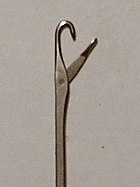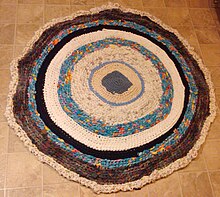Rug making
This article has multiple issues. Please help improve it or discuss these issues on the talk page. (Learn how and when to remove these template messages)
|
A rug is a piece of cloth, similar to a carpet, but it does not span the width of a room and is not attached to the floor. It is generally used as a floor covering, or as a decorative feature.[1]
Braided
Braided rugs are made by using three or more strips of fabric, usually wool, folding the raw edges to the middle and braiding them together. For an oval rug the centre braid should be one inch longer than the width-length in feet. example 2' x 4' rug centre strip would be 2'2" long. The centre braid is laced together and new strips are sewn on to make the braid longer as lacing continues.[2]
Hooking

Traditional
Rag rugs

Rag rugs were commonly made in households up to the middle of the 20th century by using odd scraps of fabric on a background of old sacking. Rag rugs became widespread during the Industrial Revolution to the nineteenth century, but by the 1920s the craft was dying out except in areas of poverty or where tradition had a stronger hold. The necessity for thrift during World War II brought a brief revival, but it did not last long.[3]
Prodded
Proddy rugs are made, as the name implies, by prodding or poking strips of fabric through hessian or linen from the back side. Rag rugs made this way have many names, such as clippies, stobbies, clippers and peggies.[4] In Northumberland they are called proggy mats, and in Scotland they are called clootie mats. They were often made for more utilitarian use such as by the back door, their pile hiding dirt well.
The Museum of English Rural Life has a collection of rug-making tools and thrift rugs.[3]
Woven
These are both handmade and machine-made (see
See also
- Afghan carpet
- Armenian carpet
- Azerbaijani carpet weaving
- Flooring
- Gabbeh
- Heatsetting
- Knot density
- Oriental rugs
- Tapestry
- Moroccan rugs
References
- ^ "RUG | meaning in the Cambridge English Dictionary". dictionary.cambridge.org. Retrieved 2020-09-29.
- ^ a b c "Ask An Expert: Types of Weave: Hand Knotted, Hand Tufted Flat Weave". RugScout. Archived from the original on 3 December 2010. Retrieved 1 April 2019.
- ^ a b "Hemeon, Maidie (rug maker)". The Museum of English Rural Life. Retrieved 11 November 2019.
- ISBN 978-1-61423-948-2.
